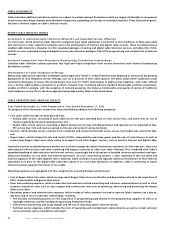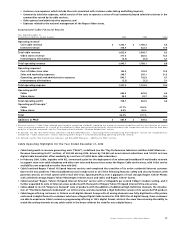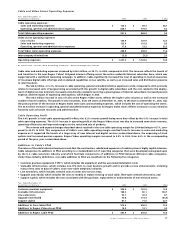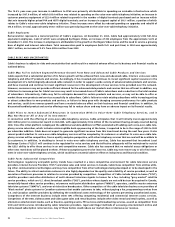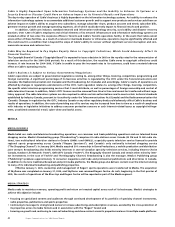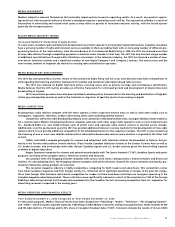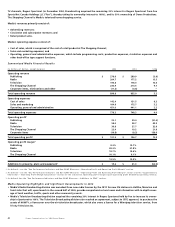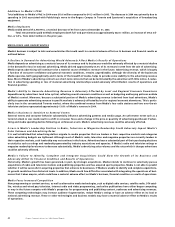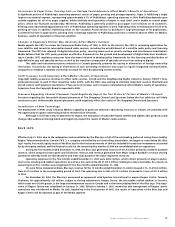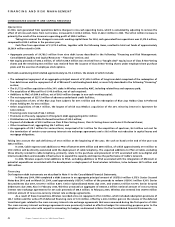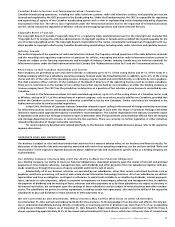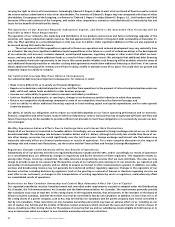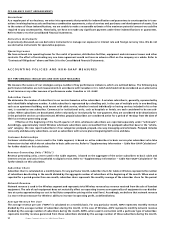Rogers 2004 Annual Report Download - page 46
Download and view the complete annual report
Please find page 46 of the 2004 Rogers annual report below. You can navigate through the pages in the report by either clicking on the pages listed below, or by using the keyword search tool below to find specific information within the annual report.
44 Rogers Communications Inc. 2004 Annual Report
Additions to Media’s PP&E
Total additions to Media’s PP&E in 2004 were $19.6 million compared to $41.3 million in 2003. The decrease in 2004 was primarily due to
spending in 2003 associated with Publishing’s move to the Rogers Campus in Toronto and Sportsnet’s acquisition of broadcasting
equipment.
Media Employees
Media ended 2004 with 2,980 FTEs, a nominal decrease of 45 from 3,025 at December 31, 2003.
Total remuneration paid to Media employees (both full- and part-time) was approximately $223.1 million, an increase of $18.2 mil-
lion, or 8.9%, from $204.9 million in the prior year.
MEDIA RISKS AND UNCERTAINTIES
Media’s business is subject to risks and uncertainties that could result in a material adverse effect on its business and financial results as
outlined below.
A Decline in Demand for Advertising Would Adversely Affect Media’s Results of Operations
Media depends on advertising as a material source of its revenue and its businesses would be adversely affected by a material decline
in the demand for local or national advertising. Media derived approximately 53.5% of its revenues in 2004 from the sale of advertising.
Media expects advertising will continue to be a material source of Media’s revenue in the future. Advertising revenue, which is largely
a function of consumer confidence and general economic conditions, remains unpredictable, although the diversity of the businesses
Media operates, both geographically and in terms of the breadth of media, helps to provide some stability to the advertising revenue
base. Most of Media’s advertising contracts are short-term contracts that can be terminated by the advertiser with little notice. A reduc-
tion in advertising spending or loss of material advertising relationships would adversely affect Media’s results of operations and
financial position.
Media’s Ability to Generate Advertising Revenue is Adversely Affected by Local and Regional Economic Downturns
Expenditures by advertisers tend to be cyclical, reflecting overall economic conditions as well as budgeting and buying patterns outside
of Media’s control. Moreover, because a substantial portion of Media’s advertising revenue is derived from local advertisers, Media’s
ability to generate advertising revenue in specific markets is adversely affected by local or regional economic downturns. This is partic-
ularly true in the concentrated Toronto market, where the combined revenue from Media’s four radio stations and two over-the-air
television stations represented approximately 13.8% of Media’s revenue in 2004.
Media’s Business is Sensitive to External Events
External events and consumer behavior substantially influence advertising patterns and media usage. An unforeseen event such as a
terrorist attack or war could result in a shift in consumer focus and a change in the price or quantity of advertising purchased. If adver-
tising and media spending decline following an unforeseen event, Media’s advertising revenues could be adversely affected.
A Loss in Media’s Leadership Position in Radio, Television or Magazine Readership Could Adversely Impact Media’s
Sales Volumes and Advertising Rates
It is well established that advertising dollars migrate to media properties that are leaders in their respective markets and categories
when advertising budgets are tightened. Although most of Media’s radio, television and magazine properties are currently leaders in
their respective markets, such leadership may not continue in the future. Advertisers base a substantial part of their purchasing decisions
on statistics such as ratings and readership generated by industry associations and agencies. If Media’s radio and television ratings or
magazine readership levels were to decrease substantially, Media’s advertising sales volumes and the rates which it charges advertisers
could be adversely affected.
Media’s Failure to Identify, Complete and Integrate Acquisitions Could Slow the Growth of its Business and
Adversely Affect its Financial Condition and Results of Operations
Historically, Media’s growth has been generated, in part, by strategic acquisitions. Media intends to continue to selectively pursue
acquisitions of radio and television stations and publishing properties and has acquired sports properties. Media is not able to predict
whether it will be successful in acquiring properties that enhance its businesses. If Media is unable to identify and complete acquisitions,
its growth could slow from historical levels. In addition, Media could face difficulties associated with integrating the operations of busi-
nesses that it does acquire, which could have a material adverse effect on Media’s business, financial condition or results of operations.
Media Faces Increased Competition
New programming or content services, as well as alternative media technologies, such as digital radio services, satellite radio, DTH satel-
lite, wireless and wired pay television, Internet radio and video programming, and online publications have either begun competing,
or may in the future compete with Media’s properties for programming and publishing content, audiences and advertising revenues.
These competing technologies may increase audience fragmentation, reduce Media’s ratings or have an adverse effect on its local or
national advertising revenue. These or other technologies and business models may have a material adverse effect on Media’s results
of operations.


